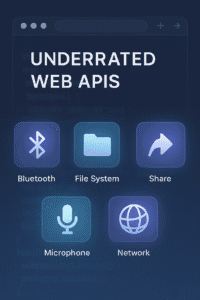
💡 Most Underrated Web APIs Developers Ignore in 2025
By 2025, it’s expected that the role of web development has expanded way past simply using DOM and event systems. Still, even though developers master fetch() and localStorage, there are some Web APIs that are used much less frequently than they should be.
Should you want to lead the way in modern web applications, look for these Web APIs that haven’t gained enough recognition.
🚀 1. Web Share API (Level 2)
Why it’s underrated:
Even though PWA and mobile-first apps use share APIs a lot, many developers keep using cumbrous custom share UIs.
What it does:
Lets the user share text, URLs, and files quickly with the apps already installed on the device.
✅ Works on Android, iOS Safari, and modern browsers.

📁 2. File System Access API
Why it’s underrated:
A large number of users continue to upload content by filling out forms or doing the drag-and-drop method.
What it does:
Enables direct reading and writing to the user’s own files so that in-browser developers can work effectively and easily upload files.
🎙️ 3. Web Speech API
Why it’s underrated:
Although most developers prefer other AI assistants, it is ready for full-scale use in applications like accessibility, chat programs, and for managing work.
What it does:
Supports both speech recognition and text-to-speech in the browser.
🧭 4. Permissions API
Why it’s underrated:
The majority of developers assume errors when it comes to permissions and move on.
What it does:
Helps access and control the working permissions for APIs including camera, location, notifications, and similar ones.
🌡️ 5. Network Information API
Why it’s underrated:
An ideal tool for managing when resources are loaded and changing performance — though it is seldom applied.
What it does:
Provides you with instant information about the user’s network (type of connection, its speed, and so on.)
🔌 6. Web Bluetooth API
Why it’s underrated:
People tend to believe that browsers can’t make use of Bluetooth. Not anymore!
What it does:
Your web app can find Bluetooth devices that are nearby and communicate with them using this technology.
Perfect for IoT dashboards, fitness devices, or smart home controls.
⚡ 7. Navigation API (v2)
Why it’s underrated:
This way, pages are switched using routing techniques similar to SPA, but not with the complete frameworks.
What it does:
It enables you to run and operate navigations like you would with usual native apps.
Useful Links
- Toil is Back: Why Even with AI, SREs Feel the Burn in 2025
- Build vs. Buy: How Developers Decide on AI Tools in 2025
- Imposter Syndrome 2.0: Competing Against AI as a Developer
- Developers vs AI-Generated Code: When Should You Trust the Machine More?
- Reinventing Search: How NLWeb and AI-Powered Answer Engines Are Changing the Web
- Remote Work Burnout: How Developers Are Coping in the AI Era
🤔 Why These APIs Matter
🧩 Reduce reliance on heavy JS libraries.
🚀 Improve performance and UX with native capabilities.
🔐 Leverage security and permission handling more reliably.
📱 Provide mobile-first and device-integrated experiences.
📚 Useful Links
❓ FAQ: Underrated Web APIs
Q1: Are all these APIs supported on all browsers?
Not always. Use CanIUse to check browser compatibility and implement graceful fallbacks.
Q2: Is the File System Access API secure?
Yes, it’s sandboxed and requires explicit user permission per file.
Q3: Can I use Web Bluetooth on all devices?
Currently, it works on Chrome-based browsers on Android and desktops, but not on iOS.
Q4: Are these APIs production-ready?
Many are stable and available behind feature detection. Always test with fallbacks and polyfills where needed.
🧠 Pro Tip: Learning and integrating these APIs can give your apps a competitive edge — while keeping dependencies light and performance high.

🚀 Let's Build Something Amazing Together
Hi, I'm Abdul Rehman Khan, founder of Dev Tech Insights & Dark Tech Insights. I specialize in turning ideas into fast, scalable, and modern web solutions. From startups to enterprises, I've helped teams launch products that grow.
- ⚡ Frontend Development (HTML, CSS, JavaScript)
- 📱 MVP Development (from idea to launch)
- 📱 Mobile & Web Apps (React, Next.js, Node.js)
- 📊 Streamlit Dashboards & AI Tools
- 🔍 SEO & Web Performance Optimization
- 🛠️ Custom WordPress & Plugin Development







